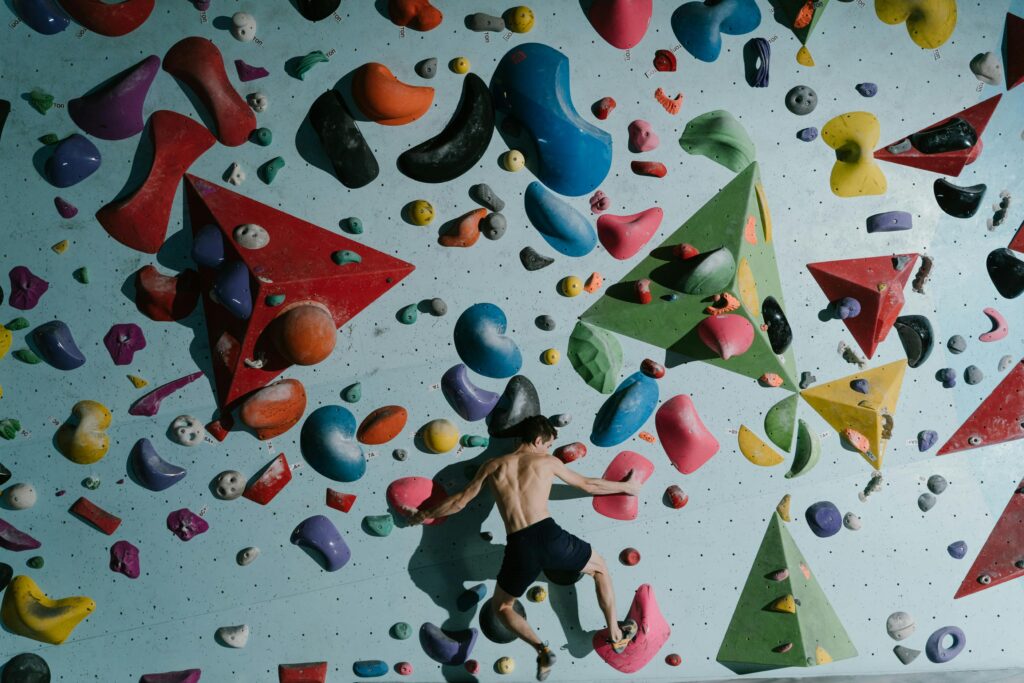/
The Early Days: Bouldering as Training
Bouldering’s origins can be traced back to the late 19th and early 20th centuries. Climbers began using large rocks and boulders to practice their techniques in a controlled environment.
- Fontainebleau, France: The sandstone boulders of Fontainebleau became a playground for climbers in the late 1800s. They used these natural formations to prepare for larger mountain expeditions.
- John Gill: Often referred to as the “father of modern bouldering,”. John Gill revolutionized the sport in the 1950s and 60s. Amazingly, a gymnast and mathematician, Gill introduced gymnastic principles and focused on bouldering as a standalone activity rather than just training for larger climbs.
The Rise of Bouldering as a Discipline
By the mid-20th century, bouldering began to establish itself as a distinct form of climbing.
- Gill’s Impact: John Gill emphasized dynamic movement and introduced the use of chalk for better grip, which became standard practice in climbing.
- Grading Systems: Gill also developed a grading system. It was used to classify the difficulty of bouldering problems, paving the way for the “V-scale” used today in North America.
- Fontainebleau’s Circuits: In France, climbers created color-coded circuits in Fontainebleau, allowing climbers to progress through problems of increasing difficulty.
The 1970s and 1980s: Bouldering Grows in Popularity
During the late 20th century saw a surge in bouldering’s popularity as climbers began to appreciate it as more than just a training tool.
- Dedicated Climbers: Legends like Jerry Moffatt and Wolfgang Güllich brought attention to bouldering through their groundbreaking ascents.
- Iconic Locations: Areas like Yosemite (USA), the Peak District (UK), and Hueco Tanks (USA) became renowned for their world-class bouldering problems.
- Crash Pads: The invention and widespread use of portable crash pads in the 1980s. They significantly improved safety, encouraging more climbers to take up the sport.
The 1990s and 2000s: Bouldering Goes Mainstream
The turn of the century marked a period of rapid growth and professionalization for bouldering.
- Indoor Bouldering Gyms: The rise of climbing gyms with dedicated bouldering areas made the sport more accessible.
- Competitions: The first official bouldering competitions emerged, culminating in events like the International Federation of Sport Climbing (IFSC) World Cups.
- Media and Films: Climbing films and online videos showcased the artistry and athleticism of bouldering, inspiring climbers worldwide.
Bouldering in the 2010s: Olympic Recognition
The 2010s solidified bouldering’s place in mainstream sports.
- Olympic Inclusion: In 2016, the International Olympic Committee announced the inclusion of sport climbing. This included bouldering, in the Tokyo 2020 Olympics (held in 2021).
- Professional Athletes: Climbers like Adam Ondra, Ashima Shiraishi, and Janja Garnbret brought global attention to bouldering through their record-breaking ascents and competition wins.
- Community Growth: Bouldering gyms became social hubs, attracting climbers of all ages and skill levels.
Bouldering Today: A Global Phenomenon
In 2025, bouldering continues to thrive as one of the most popular climbing disciplines.
- Technological Advances: Smart walls and augmented reality tools are transforming the bouldering experience, providing climbers with real-time feedback and new challenges.
- Sustainability: The climbing community is increasingly focused on preserving natural bouldering areas and minimizing environmental impact.
- Inclusivity: Bouldering remains one of the most accessible forms of climbing, with gyms and outdoor areas catering to diverse communities.
Final Thoughts
The history of bouldering is a testament to the sport’s adaptability and universal appeal. From its humble beginnings as a training tool to its status as a standalone discipline celebrated worldwide. Bouldering embodies the spirit of exploration and creativity. Whether you’re scaling a problem in Fontainebleau or tackling a colorful route in your local gym, you’re part of a rich and dynamic tradition that continues to evolve.
If you want to get started in bouldering you can check out my blog on how to get started – here

